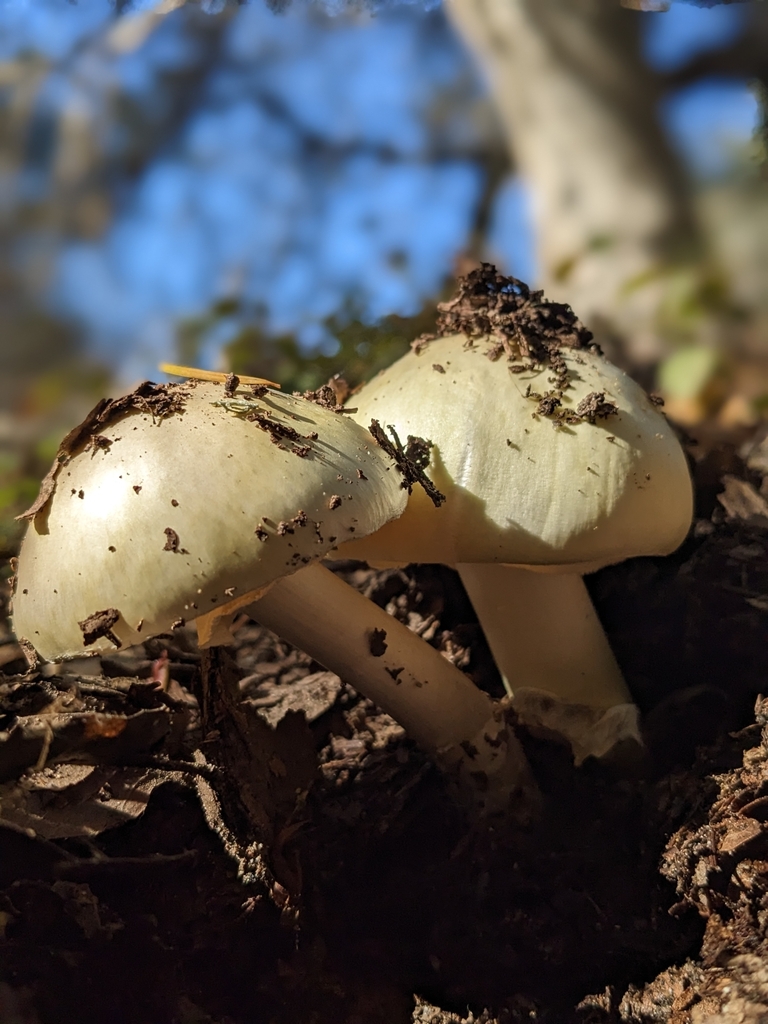[ad_1]
It’s value braving the chilliness of a rainy-season stroll at Level Reyes Nationwide Seashore. Scents of spicy bay laurel, sweet-sharp conifer, and ocean brine intermingle with a fungal aroma on this windswept peninsula, house to a kaleidoscopic array of mushrooms from tiny purple parasols to stools match for a big toad.
More and more as of late, you’ll see scads of enticing mushrooms sporting caps in various combos of yellow, inexperienced, and brown. They’re Amanita phalloides—“demise caps,” generally—the supply of most mushroom fatalities worldwide and the bane of unwary foragers. And they’re fruiting now.

They’re comparatively current arrivals, really. Demise caps are the primary invasive ectomycorrhizal (ECM) fungus reported in North America. ECM fungi develop linked with the foundation suggestions of woody crops, permitting fungus and plant to swap vitamins. The fungi seemingly arrived by ship, stowing away aboard crops imported from Europe. Demise caps have been first noticed in 1938 on the grounds of the previous Del Monte Resort in Monterey, and now develop on the West Coast from Los Angeles to British Columbia, and east to Idaho, together with deep inside native forests. They emerged on the East Coast within the Seventies however, in contrast to their West Coast cousins, stay restricted in vary there.
The Bay Space’s demise caps win the prize for being bigger and extra considerable than anyplace else, based on mycologist Benjamin Wolfe, an affiliate professor of biology at Tufts College. In examine websites at Level Reyes Nationwide Seashore he discovered that demise caps dominated native mushrooms by sheer mass. The mushrooms you see, after all, are simply the seen intercourse components of the bigger fungal particular person, or mycelium, residing underground. “It’s tough, particularly in locations like Level Reyes, to stroll within the woods and see as many demise caps as big and prolific as they’re and picture that it’s not disturbing pure associations and even shifting plant communities,” says Mickey Drott, a mycologist on the U.S. Division of Agriculture’s Cereal Illness Lab in St. Paul, Minn., who research how fungal toxins form their evolution. “Even the mycorrhizal connections are large,” says Debbie Viess, cofounder of the Bay Space Mycological Society. “You possibly can see them with the bare eye!”
“It’s tough, particularly in locations like Level Reyes, to stroll within the woods and see as many demise caps as big and prolific as they’re and picture that it’s not disturbing pure associations and even shifting plant communities.”
Mickey Drott, U.S. Division of Agriculture mycologist
Why is the Bay Space a hotbed of demise caps? First, they appear to like the gentle local weather. Second, they’ve gone “host leaping,” transferring from the roots of imported bushes similar to European cork oaks to coast stay oaks, that are evergreen and thus give them a year-round provide of carbon from photosynthesis. Extra carbon could translate to extra and greater mushrooms, which, in flip, means extra spores for spreading demise caps. It additionally implies that they might be competing for underground habitat beneath oaks with foragers’ beloved chanterelles, Cantharellus californicus, based on Viess.

However there’s a new and attractive twist to the story. Mycologist Yen-Wen (Denny) Wang, now a postdoc at Yale College of Public Well being, was learning the origin of demise caps at Level Reyes when he found mushrooms containing DNA from only one mum or dad as a substitute of the traditional two. Then a grad pupil in Anne Pringle’s lab on the College of Wisconsin-Madison, Wang seemed underground—and located particular person mycelia that have been able to sexually reproducing both solo or with a mate. “I used to be fairly excited,” he remembers. To his data, his remark—revealed not too long ago in Nature Communications—is the primary in nature of unisexual fruiting our bodies among the many agaricomycetes, a big group encompassing mushrooms, puffballs, and shelf fungi.
Unisexuality is a robust reproductive technique, for those who can swing it. (It requires only one mum or dad to provide spores.) “You solely want some people which are able to doing this to begin institution,” notes Wang. It’s simple to see how that will facilitate invasions. Wang suspects that investigating the invasion fronts on the West Coast could uncover extra unisexual demise caps.
In the meantime, Drott’s analysis in collaboration with the Pringle lab provides one other chance. He and his coauthors have discovered that the gathering of toxin genes in Californian demise caps differs from these in Europe, and even varies amongst particular person fungi. Drott hypothesizes that evolving a various suite of poisons could enable demise caps to unfold to new ecological niches—probably by suppressing competing organisms, or by stopping varied critters from noshing on the mushrooms. However each Wang and Drott emphasize that they haven’t proved these hypotheses. ”We’d like extra knowledge,” says Wang.

“I feel it’s a very cool state of affairs,” says ectomycorrhizal fungus knowledgeable Laura Bogar on these potential explanations for the demise cap invasion. Bogar, an assistant professor of plant biology at U.C. Davis, is establishing a brand new lab to review mechanisms underlying plant-fungal interactions. She says {that a} tremendous profitable invasive species seemingly advantages from having such particular tips up its sleeve—and getting fortunate with the environments it encounters. Certainly, she and collaborators not too long ago revealed an article detailing a “fungal battle membership” method to figuring out the elements—fungal and environmental—that enable one ectomycorryizal fungus to outcompete others. Such research are uncommon, although. Most ectomycorrhizal fungi are, to this point, tough or not possible to develop within the lab, which makes causation tough to ascertain, based on Bogar.
The Pringle lab will preserve engaged on fixing this invasion thriller, aided by new genetic strategies which have reworked mycology in recent times. In the meantime, Drott, usually a mould researcher, jokes, “Engaged on demise caps has dramatically elevated the extent of curiosity I get at cocktail events.”
[ad_2]

